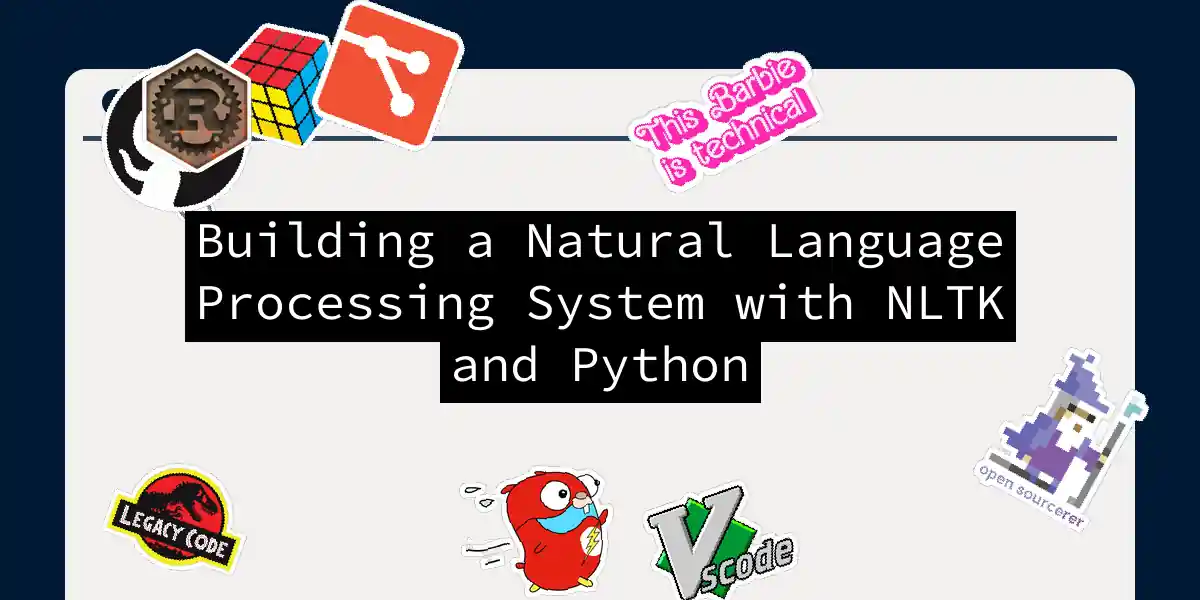Why NLP Isn’t Just Alphabet Soup
Natural Language Processing is like teaching a toaster to appreciate poetry—it sounds absurd until you realize we’re actually doing it. As developers, we get to bridge human ambiguity with machine precision. Today, we’ll build an NLP pipeline using Python’s NLTK library that can dissect text like a linguist on espresso. No PhD required—just Python and stubbornness.
Your NLP Toolkit Setup
Before our text adventures begin, let’s weaponize your Python environment:
1. Install NLTK
Pop this in your terminal:
pip install nltk
2. Download Linguistic Superpowers
Run this in Python to grab essential datasets:
import nltk
nltk.download('punkt') # Word-slicing ninja
nltk.download('stopwords') # Filters the "chaff"
nltk.download('wordnet') # Thesaurus on steroids
nltk.download('averaged_perceptron_tagger') # Grammar police
nltk.download('maxent_ne_chunker') # Name-spotting detective
Text Processing Pipeline: From Chaos to Order
Here’s how we transform raw text into machine-digestible insights:
Step 1: Tokenization – Breaking Down the Wall
Split text into words/sentences:
from nltk.tokenize import word_tokenize, sent_tokenize
text = "NLP? More like 'Not-Lame-Python'! Change my mind."
words = word_tokenize(text) # ['NLP', '?', 'More', 'like', ...]
sentences = sent_tokenize(text) # ["NLP? More like 'Not-Lame-Python'!", ...]
Step 2: Evicting Stopwords
Kick out meaningless filler words:
from nltk.corpus import stopwords
stop_words = set(stopwords.words('english'))
filtered_words = [word for word in words if word.lower() not in stop_words]
# ['NLP', '?', 'Not-Lame-Python', '!', 'Change', 'mind', '.']
Step 3: Lemmatization – Word Roots Demystified
Reduce words to dictionary form:
from nltk.stem import WordNetLemmatizer
lemmatizer = WordNetLemmatizer()
lemmatized = [lemmatizer.lemmatize(word, pos='v') for word in filtered_words]
# ['NLP', '?', 'Not-Lame-Python', '!', 'Change', 'mind', '.']
Step 4: POS Tagging – Grammar Spy Game
Label words by their grammatical role:
pos_tags = nltk.pos_tag(lemmatized)
# [('NLP', 'NNP'), ('?', '.'), ('Not-Lame-Python', 'NN'), ...]
Step 5: Entity Recognition – The Name Game
Extract real-world objects:
from nltk import ne_chunk
entities = ne_chunk(pos_tags)
# [Tree('GPE', [('NLP', 'NNP')]), ...]
Building a Sentiment Analyzer
Let’s create an emotion detector for text:
Training Data Prep
from nltk.sentiment import SentimentIntensityAnalyzer
nltk.download('vader_lexicon') # Pre-trained sentiment model
sia = SentimentIntensityAnalyzer()
text = "I'd rather debug assembly than live without NLP!"
sentiment = sia.polarity_scores(text)
# {'neg': 0.0, 'neu': 0.423, 'pos': 0.577, 'compound': 0.5719}
Interpreting Scores:
- Positive:
compound >= 0.05 - Neutral: Between -0.05 and 0.05
- Negative:
<= -0.05
Why Your Code Needs NLP
Beyond academic exercises, here’s where this shines:
- Customer Feedback: Automatically flag angry emails
- Content Moderation: Detect toxic language
- Research: Analyze survey responses at scale
When Things Get Weird: Edge Cases
NLP isn’t perfect. Try analyzing these:
quirk = "I never said she stole my money." # 7 meanings!
sia.polarity_scores(quirk)['compound'] # 0.0 (neutral 🤷)
Next Steps for the NLP Curious
- Advanced: Combine with spaCy for industrial-strength pipelines
- Machine Learning: Train custom classifiers
- APIs: Hook into GPT-4 for generative tasks Remember: Language is messy, but that’s where the fun begins. Now go make your code understand sarcasm (good luck with that).
